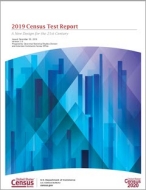2019 Census Test Report
2019 Census Test Report
Executive Summary
In 2018, the U.S. Census Bureau decided to test the operational implications of a proposed question on citizenship status on the 2020 Census. In particular, experts and stakeholders raised concerns that such a question could depress self-response rates, increase cost, and reduce the quality of the 2020 population count. An indirect study by Census Bureau researchers predicted that “adding a citizenship question to the 2020 Census would lead to lower self-response rates in households potentially containing noncitizens…” compared to households with all citizens (Brown, Heggeness, Dorinski, Warren, & Yi, 2018). However, the authors recommended the ideal analysis would be to conduct a randomized controlled experiment to compare response rates on questionnaires with and without a citizenship question.1
The Census Bureau was interested in understanding whether the citizenship question would depress self-response rates and, if so, where that may occur. In particular, the Census Bureau wanted to know if it needed to adjust its planned hiring for enumerators in certain areas and possibly identify communities that would benefit from additional communications and partnership activity to mitigate impacts on self-response and encourage residents to open their doors for enumerators. Thus, the Census Bureau conducted the 2019 Census Test, a nationally representative randomized experiment designed to study the potential impact on self-response of including a citizenship question on the 2020 Census questionnaire.
Invitations to complete the 2019 Census Test were sent to 480,000 housing unit addresses across the country. These addresses were randomly assigned to one of two treatments, and residents were asked to respond to the 2019 Census Test questionnaire. One test questionnaire included the question on citizenship; the other test questionnaire did not. Both test questionnaires included all questions that are planned for the 2020 Census: age, sex, Hispanic origin, race, relationship, and homeownership status.
The major finding of the 2019 Census Test was that there was no statistically significant difference in overall self-response rates between treatments. The test questionnaire with the citizenship question had a self-response rate of 51.5 percent; the test questionnaire without the citizenship question had a self-response rate of 52.0 percent. Although these results differ from the predicted rates in Brown’s et al. study, the results of the two studies are not comparable since this study benefits from the randomized controlled design, which isolates the treatment effect.
However, in some areas and for some subgroups, there were statistically significant lower self-response rates for the test questionnaire with the citizenship question than for the test questionnaire without the citizenship question. These differences were observed for the following:
- Mail respondents
- Tracts designated to receive bilingual materials.
- Tracts with greater than 4.9 percent noncitizens.
- Tracts with greater than 49.1 percent Hispanic residents.
- Tracts with between 5.0-20.0 percent Asian residents.
- Housing units within the Los Angeles Regional Census Center and New York Regional Census Center boundaries.
In addition, the proportion of those who identified as Hispanic (and were listed as the first person on the questionnaire) was statistically significantly lower for the treatment with the citizenship question.
Additional analysis was conducted on partial internet responses, which are responses in which the respondent started but did not complete the questionnaire. Among internet respondents, there was a statistically higher rate of partial responses in the treatment with the citizenship question compared to the treatment without the citizenship question. Those breakoffs occurred during the collection of person demographics at a higher rate for the treatment with the citizenship question.
Although the 2020 Census will not include a citizenship question, results from this test may help inform operational decisions for future censuses and surveys. Based on the results of this experiment, had the citizenship question been included in the 2020 Census, it would not have affected staffing needs for the Nonresponse Followup operation, which is designed to collect responses from households that do not self-respond. Current plans for staffing for Nonresponse Followup would have sufficiently accounted for subgroup differences seen in this test. Note that this test did not include the Nonresponse Followup operation, so we are not able to measure the impact of a citizenship question for the completeness and accuracy of the 2020 Census overall. Furthermore, the results of the 2019 Census Test will not trigger a major change in our communications campaign strategy, which was built on prior research that indicated self-response differs across communities, and some populations may be fearful about participating in the census, regardless of the presence of a citizenship question.




